
Quantifying Hope
Hope might seem like the business of philosophers and motivational speakers. But economists, too, are exploring the power of aspirations.
More than 800 million people in the world live in extreme poverty, surviving on less than $1.90 a day. Interventions usually focus on providing tangible resources, such as access to clean water, nutrition, health care, education and a viable income.
But new research from economists in the College of Agricultural and Environmental Sciences highlights a psychological asset that could be equally important: hope.
“Hope alone won’t solve global poverty,” said Professor Michael Carter, economist and director of the Feed the Future Innovation Lab for Assets and Market Access at UC Davis. “But other interventions may be more successful if they recognize the vital role that hope can play.”
Closing Your Eyes on a Dismal Future
Planning for the future can improve economic prospects. But planning requires optimism in order to set a goal, see a pathway and believe you have the power to take those steps. For people trapped in poverty, the future may be too dark to see.
“We stop wanting what we can’t have,” Carter explained. “Otherwise, it’s too painful.”
Researchers at the Innovation Lab for Assets and Market Access recently looked at aspirations among a group of poor farmers in Mozambique. To gauge farmers’ “time horizon,” researchers asked participants how far out they planned for expenditures. The poorest of the poor didn’t look very far ahead.
“When you’re worried about what your family will eat tomorrow, you’re not thinking about whether your child will get into secondary school,” Carter said. “Closing your eyes on a gloomy future can reduce psychological distress at the cost of worsening your prospects for economic well-being.”
Economic interventions can raise aspirations. Researchers offered some Mozambique farmers a one-time voucher for maize seeds and fertilizer. The farmers who used the subsidy expanded both their farming operations and their outlook on life.
“It appears that hope and planning can coevolve with relaxation of economic constraints,” Carter said.
When Internal Constraints Persist
Sometimes, however, hopelessness continues even after conditions change.
“When people are subjected to external constraints long enough, they can internalize those limitations,” said Professor Travis Lybbert, a development economist and researcher with the Innovation Lab. “A person’s perception of her own power can become so degraded that she isn’t able to take advantage of opportunities.”
In a recent experiment in Oaxaca, Mexico, Lybbert and his colleagues addressed those internal issues and were able to help clients of a microcredit bank expand their horizons. Lybbert’s team created and then showed a documentary to 326 indigenous women who were eligible for small loans from a community bank. The 15-minute film featured four women who used similar loans to successfully grow small enterprises such as clothing stalls and food stands to help their families thrive.
“Seeing women like them succeed opened their eyes to what they could accomplish, too,” Lybbert said.
After viewing the documentary, the women took part in a year-long program where they set goals, discussed hopes and fears, and charted a course out of poverty.
“We find inspiration from people who are like us,” Lybbert said. “It expands our notion of what we think is possible.”
Widening the Lens
Lybbert is also conducting research in Haiti, the poorest country in the Western Hemisphere. More than 75 percent of Haitians live on less than $2 a day, and yet many of them spend much of their meager wages on the lottery. That might seem like self-defeating behavior, but when everyone around you is trapped in poverty, winning the lotto can look like the only way out.
“It’s important to view behavior through the eyes of the people making the decisions,” Lybbert said. “That’s one of the key insights from this research. It provides perspective and enriches our understanding. When we recognize people’s internal and external constraints, we’re better able to understand what works to alleviate poverty.”
Carter and his team recently began a five-year project in Kenya to measure the role that hope plays in poor farmers’ lives. His team is also weighing whether adding a “hope curriculum” to an asset transfer program in Peru will increase its impact.
“We’re looking at whether improving the mental health of one person has a spillover effect that can benefit families and communities,” Carter said. “Poverty can set up a self-reinforcing loop of stress and despair. By addressing economic circumstances, as well as outlook, perhaps we can help turn a downward spiral into an upward path."